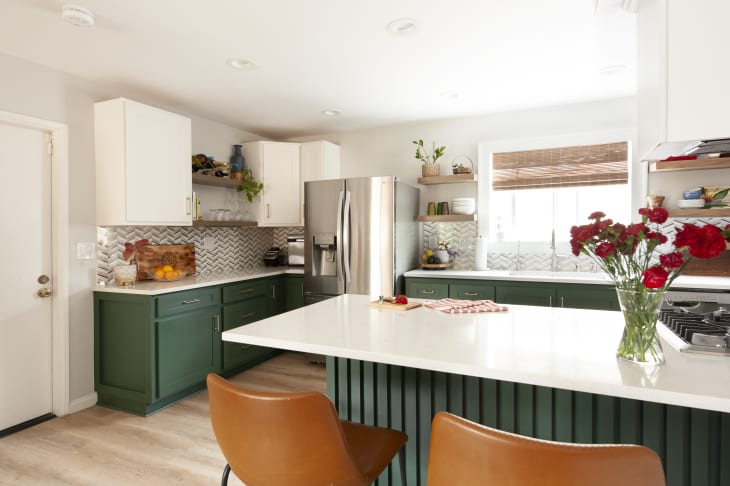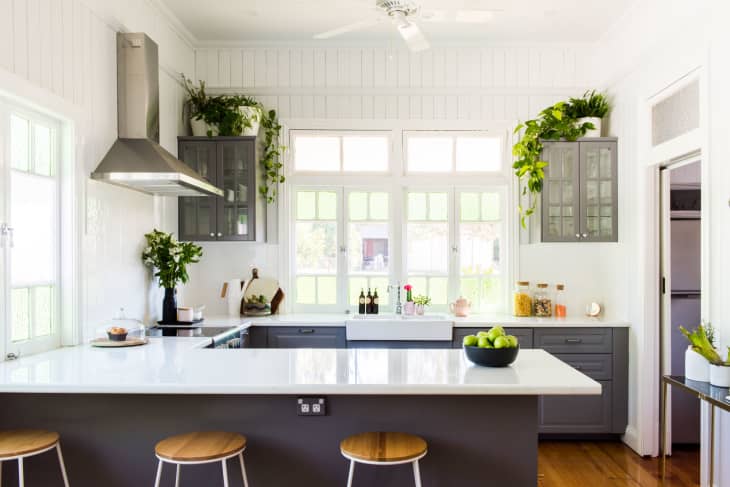

The report found that homes with olive green kitchens attract more buyer interest than any other color. In fact, kitchen cabinets in this shade could increase a home’s sale price by about $1,600, according to Zillow’s analysis. It’s a “timeless, grounding color,” according to Sue Wadden, the director of color marketing for Sherwin-Wiliams.
Zillow’s new finding supports a trend designers highlighted at the start of the year: According to the National Kitchen and Bath Association’s (NKBA) 2025 kitchen trend report, all hues and shades of green are dominating the scene. Homebuyers today want neutral, warm, and earthy tones, says Simone Bumpus, a design consultant for Kitchens by Good Guys, a kitchen remodeler in Scottsdale, Arizona. “A little pop of green adds a bit of color, but it is still toned-down,” she says.
How Do Green Kitchens Win Over Buyers?
When it comes to kitchen colors, real estate agents agree that green has influence. Olive is a clear favorite, along with sage green, says Colorado-based Modus real estate agent Sarah Thomsen.
“Olive comes across as rich and timeless, while sage is a bit softer and has this airy, natural vibe,” she says. “They both work really well with things like matte black or brushed brass hardware, which adds a nice modern touch. Are these all trends? Yes, but they can feel timeless for years if done well.”
In general, color can be somewhat polarizing, Thomsen explains. But she says she’s noticed it makes buyers “lock in” more to a particular home — they just have to have the “green kitchen house” they saw. But if house hunters aren’t so hot on a particular color, and they see it in online photos, it could turn them off enough that they never book a showing.

What Shades of Green Work Best in a Kitchen?
Designers are using low-saturation greens like sage, laurel, and silvered olive not just for the aesthetic appeal, but also to reshape how light behaves in a kitchen, says Thomas Borcherding, owner and lead designer at Homestar Design Remodel in St. Louis.
“These tones reflect indirect light without glare, making even north-facing kitchens feel airy, a trick borrowed from Scandinavian cabin design,” he says. In general, he says, muted greens produce a calming feeling, akin to spending time in nature.
Where Does Green Make the Biggest Impact in a Kitchen?
The Zillow study homes in on green as a choice for timeless kitchen cabinet colors, but design and real estate professionals say the muted shades of green can work wonderfully in other parts of the kitchen, too. For homeowners who plan to sell their home in the near future, Borcherding encourages incorporating green as a wall color or as a backsplash.
Using a non-neutral color on cabinetry can potentially harm resale value and marketability, experts warn. But it could also be a high-risk, high-reward scenario: “In a world of white subway tile and gray shaker cabinetry, eccentric cabinetry colors might be just what the market needs,” Borcherding says.
Green makes a big impact when it’s used as a backsplash, Thomesen seconded. “A green backsplash — maybe sage subway tile or something bolder like olive zellige — adds personality without locking you into a full green kitchen,” she says. “And if someone doesn’t love it down the line, it’s a pretty easy change compared to redoing cabinets.”

What Other Kitchen Color Helps a Home Sell for More?
Millennial gray may get a bad rap, but in the kitchen dark gray is still faring pretty well. Zillow’s research found that homes with a dark gray kitchen can sell for an estimated $2,400 more. One caveat, though? Not as many buyers are sold on a gray kitchen, so while you may net some slightly higher offers, you may also get fewer of them, according to the study.
Thomesen points out that a lot of new builds go with neutral gray kitchens, but buyers aren’t snapping them up — not because the kitchen is gray, but rather because the house is brand new.
In general, gray is trending out, so Bumpus recommends against incorporating it into your kitchen for resale value specifically. But if you do opt for gray, go for warmer tones instead of the cooler ones that have been trending for the last decade.
The bottom line: In the kitchen, nature-inspired greens are having a major main-character moment.